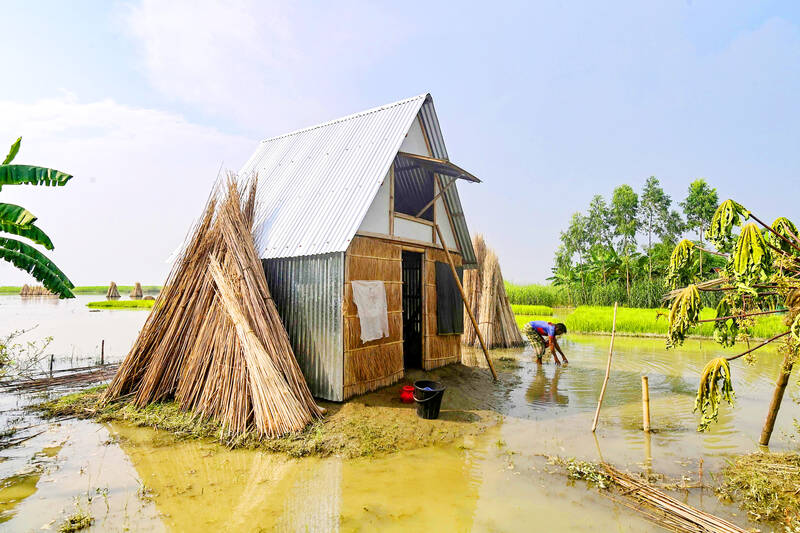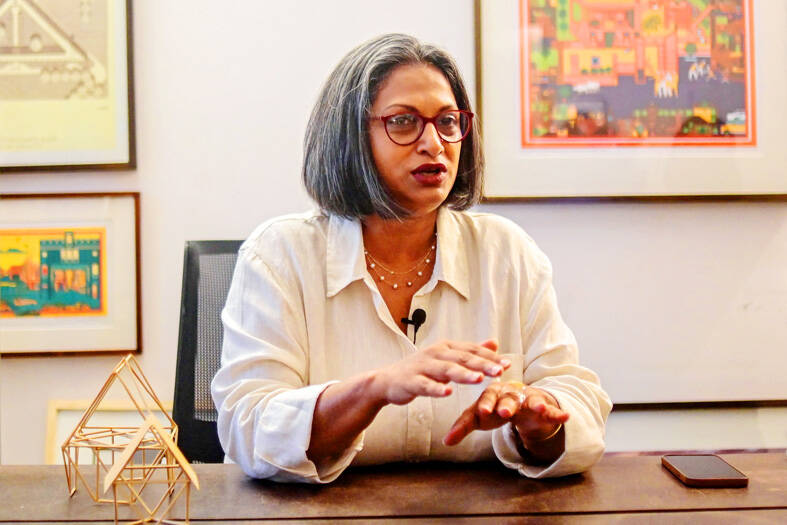An award-winning architect in Bangladesh, one of the nations most at risk from flooding driven by climate change, has developed an ingenious two-floor housing solution to help people survive what scientists warn is a growing threat.
This year, when the annual monsoon floodwaters swelled the country’s mighty Brahmaputra River, 40-year-old farmer Abu Sayeed did not have to abandon his home for the first time in his life — but merely climb up a ladder and wait out the waters.
The Khudi Bari, or “tiny house” — resilient homes made on bamboo stilts rising out of the floodwaters that are also easy to move to safer locations when needed — offer hope to millions.

Photo: AFP
“Khudi Bari has saved us,” said Sayeed, who like millions, lives on Bangladesh’s vast river floodplains because the fertile soil is good for the maize and chilli crops he grows.
“We did not leave ... we slept on the upper floor. I hope we will never have to flee our homes thanks to this house,” he said.
Bangladesh is listed as the seventh most vulnerable to extreme weather caused by climate change and rising sea levels, environmental rights organization Germanwatch says.

Photo: AFP
Much of Bangladesh is made up of deltas as the Himalayan rivers of the Ganges and Brahmaputra slowly wind through the low-lying country toward the sea.
With millions at risk, relocating people to higher ground is a near-impossible task.
“Fleeing your home during the floods is part of your life,” said Sayeed, from the northern village of Shildaha, where 17 prototype Khudi Bari houses have been built by Bangladeshi architect Marina Tabassum.
“Often, when the floodwater recedes, you come back to see that your goods were all stolen,” Sayeed said.
Scientists warn of the growing effects of climate change increasing the intensity of monsoon rains, and say that ice in the Himalayas is melting faster than ever before.
Last year, floods in Bangladesh’s northeastern Sylhet region were some of the worst on record, leaving millions stranded, while about 100 people were killed.
The government has built thousands of strongly built shelters for cyclones to withstand the severe storms that are also increasing in regularity.
However, although they do reduce fatalities, cyclone shelters are suitable only for hunkering down during the short span of a storm, and floods can swamp land for months.
Tabassum said that she worked to design a home for the “lowest cost possible for those in need,” using locally available materials by combining bamboo poles and metal sheeting.
Winner of the Aga Khan Award for architecture for her design of the Bait-ur-Rouf Mosque in Dhaka, and designer of the country’s Independence Monument, Tabassum developed prototype shelters to test them against flash floods and heavy winds.
“It can be assembled and disassembled very easily,” she said, calling it a “climate preparedness” project, with each house costing about US$450 to build, including labor.
“It’s a mobile modular system, so that’s why it can be moved from one location to another,” said Tabassum, the winner of Britain’s Soane Medal for architecture in 2021, including for her tiny house work.
Most of the Khudi Bari owners use their own solar panels, said Mohammad Azam Khan whose charity the National Development Programme joined with Tabassum’s organization to build the homes for farmers.
Arman Abedin, an associate of Tabassum, said every 4m-high house has two floors, each 9.3m2.
He said the architect has also used the Khudi Bari model to build a larger community center for Rohingya refugee women in the Bangladeshi camps.
Mohammad Kalu, 35, who lives in one of the Shildaha homes on stilts, said the design means people can easily adapt.
“If water rises to the chest or even cheek level, still we can stay in this house... We can go to the upper floor and cook with gas or firewood,” he said. “When the current is strong, we untie the tin walls and the water goes through our houses without any obstruction.”
Tabassum said she was partly influenced by the traditional wood homes of Bangladesh’s central Munshiganj, which are raised on stilts to allow floodwaters to pass under them during monsoon season.
Yet Sayeed said the design meant the new houses — with wooden stilts wrapped in metal covers — were far easier to move than traditional constructions.
“Now we don’t need to buy new materials when we disassemble the houses,” he said.
Tabassum is busy building more than a hundred Khudi Bari across Bangladesh to offer an example and inspiration for others.
Mohammad Jashim, who sells flat-pack wood homes in Munshiganj, said similar raised wooden home designs were proving popular.
“We are selling these homes all over the country,” he said. “They are environmentally friendly, can be easily relocated and can resist floods.”

Mercuries Life Insurance Co (三商美邦人壽) shares surged to a seven-month high this week after local media reported that E.Sun Financial Holding Co (玉山金控) had outbid CTBC Financial Holding Co (中信金控) in the financially strained insurer’s ongoing sale process. Shares of the mid-sized life insurer climbed 5.8 percent this week to NT$6.72, extending a nearly 18 percent rally over the past month, as investors bet on the likelihood of an impending takeover. The final round of bidding closed on Thursday, marking a critical step in the 32-year-old insurer’s search for a buyer after years of struggling to meet capital adequacy requirements. Local media reports

TECHNOLOGICAL RIVALRY: The artificial intelligence chip competition among multiple players would likely intensify over the next two years, a Quanta official said Quanta Computer Inc (廣達), which makes servers and laptops on a contract basis, yesterday said its shipments of artificial intelligence (AI) servers powered by Nvidia Corp’s GB300 chips have increased steadily since last month, should surpass those of the GB200 models this quarter. The production of GB300 servers has gone much more smoothly than that of the GB200, with shipments projected to increase sharply next month, Quanta executive vice president Mike Yang (楊麒令) said on the sidelines of a technology forum in Taipei. While orders for GB200 servers gradually decrease, the production transition between the two server models has been

US sports leagues rushed to get in on the multi-billion US dollar bonanza of legalized betting, but the arrest of an National Basketball Association (NBA) coach and player in two sprawling US federal investigations show the potential cost of partnering with the gambling industry. Portland Trail Blazers coach Chauncey Billups, a former Detroit Pistons star and an NBA Hall of Famer, was arrested for his alleged role in rigged illegal poker games that prosecutors say were tied to Mafia crime families. Miami Heat guard Terry Rozier was charged with manipulating his play for the benefit of bettors and former NBA player and

BETTER THAN EXPECTED: The firm’s Q3 results exceeded its projections, based on ‘the underlying strength of our core markets,’ chief financial officer Dave Zinsner said Intel Corp returned to profitability and gave an upbeat revenue forecast after PC demand grew, suggesting that it is making progress on a long and challenging comeback attempt. In the third quarter, revenue rose 3 percent to US$13.7 billion. The Santa Clara, California-based company posted its first quarterly net income since the end of 2023, with earnings per share of US$0.23, excluding some items. Analysts had estimated sales of US$13.2 billion and earnings per share of US$0.01 on average, according to data compiled by Bloomberg. Fourth-quarter sales would be roughly US$13.3 billion, the company said in a statement on Thursday. Intel shares gained about